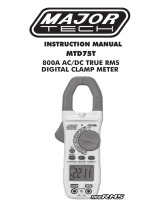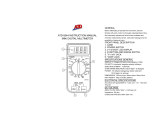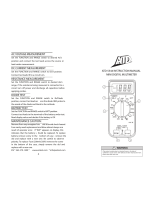Page is loading ...

MN36-en-GB_V2.2 7/17
Safety
This symbol, adjacent to another symbol or terminal, indicates
the user must refer to the manual for further information.
This symbol, adjacent to a terminal, indicates that, under
normal use, hazardous voltages may be present
Double insulation
1. Improper use of this meter can cause damage, shock, injury or death.
Read and understand this user manual before operating the meter.
2. Make sure any covers or battery doors are properly closed and ured.
3. Always remove the test leads before replacing the battery or fuses.
4. Inspect the condition of the test leads and the meter itself for any
damage before operating the meter. Repair any damage before use.
5. Do not exceed the maximum rated input limits.
6. Use great care when making measurements if the voltages are
greater than 25VAC rms or 35VDC. These voltages are considered a
shock hazard.
7. Always discharge capacitors and remove power from the device
under test before performing Diode, Resistance or Continuity tests.
8. Remove the battery from the meter if the meter is to be stored for
long periods.
9. To avoid electric shock, do not measure AC current on any circuit
whose voltage exceeds 250V AC.
Input Limits
Function
Maximum Input
VDC, VAC
600V AC/600V AC
Resistance, Diode, Continuity
500V DC/AC
mA DC
200mA DC
10A DC
10A DC (15 seconds max.
every 15 min.)
Frequency
250V DC/AC
User Manual
MiniTec
TM
Series
Model MN36
Auto-Ranging Mini MultiMeter
Introduction
Congratulations on your purchase of Extech’s MN36 Auto-Ranging
Multimeter. This meter measures AC/DC Voltage, AC/DC Current,
Resistance, Capacitance, Frequency, Temperature, Diode Test and
Continuity. Proper use and care of this meter will provide many years of
reliable service.
Specifications
Accuracy Stated at 23
o
C ±5
o
C (73
o
F
±10
o
F) and less than
70% RH
Diode Test Test current of 0.6mA maximum, open circuit
voltage 1.5V DC typical
Continuity Check Audible signal will sound if the resistance is less
than approximately <8Ω
Temperature sensor Requires type K thermocouple
Input Impedance 10MΩ (V AC/DC)
Display 3999 count LCD
Overrange “OL” is displayed
Polarity Automatic (no indication for positive polarity);
Minus (-) sign for negative polarity.
Measurement Rate 3 times per second, nominal
Low Battery “ ” is displayed if battery voltage drops below
operating voltage
Batteries Requires (2) AAA batteries
Fuses mA range; 250mA/250V fast blow
10A range, no protection
Operating Temp 0
o
C to 40
o
C (32
o
F to 104
o
F)
Storage Temp -20
o
C to 60
o
C (-4
o
F to 140
o
F)
Relative Humidity Maximum relative humidity 80% for temperatures
up to 31°C decreasing linearly to 50% relative
humidity at 40°C.
Operating Altitude 2000 meters (7000ft) maximum
Weight 153g (5.4 oz.)
Size 138mm x 72mm x 38mm (5.43” x 2.83” x 1.5”)
Safety For indoor use and in accordance with
Overvoltage Category II, Pollution Degree 2.
Category II includes local level, appliance,
portable equipment, etc., with transient
overvoltages less than Overvoltage Category III
Specifications
Function
Range
Accuracy
DC Voltage
(V DC)
400.0mV
±
(0.5% reading + 4 digits)
4.000V
±(0.8% reading + 4 digits)
40.00V
400.0V
600V
AC Voltage
(V AC)
50-60Hz
40-400Hz
4.000V
±(0.8% rdg + 4 d)
±(2% rdg + 5 d)
40.00V
±(1.2% rdg + 5 d)
400.0V
600V
DC Current
400.0µA
±(1.2% reading + 4 digits)
4000µA
40.00mA
200.0mA
10A
±(2.5% reading + 4 digits)
AC Current
(40 to 400Hz)
400.0µA
±(1.5% reading + 5 digits)
4000µA
40.00mA
200.0mA
10A
±
(3% reading + 5 digits)
Resistance
400.0Ω
±(1.2% reading + 4 digits)
4.000kΩ
40.00k
Ω
400.0k
Ω
4.000M
Ω
20.00M
Ω
±
(3.0% reading + 5 digits)
Capacitance
4.000nF
Not specified
40.00nF
±(3.0% reading + 10 digits)
400.0nF
4.000µF
40.00µF
Not Specified
100µF
Frequency
10.00Hz
±(1.0% reading + 4 digits)
10Hz to 1MHz
Sensitivity: 5.0Vrms
100Hz
1.000kHz
10.00kHz
100.0kHz
1.000MHz
5.000MHz
Not specified
Temp °F
Temp °C
-40 to
1400°F
-20 to 750°C
-40 to 650°F; ±(1.0% rdg + 10 digits)
651 to 1400°F; ±(3% rdg + 10 digits)
-20 to 400°C; ±(1.0% rdg + 10 digits)
400 to 750°C; ±(3% rdg + 10 digits)
(probe accuracy not included)

MN36-en-GB_V2.2 7/17
Symbols
AC (voltage)
DC (direct current or voltage)
•))) Continuity and Diode test
mV, V millivolt, volt (voltage)
Ω, kΩ, MΩ ohm, kilohm, megohm (resistance)
µA, mA, A microamp, milliamp, Amp (current)
o
F,
o
C Degrees fahrenheit, centigrade (temperature)
Low battery
H Display hold
Meter Description
1. LCD Display
2. DATA HOLD button
3. SELECT button
4. Function switch
5. Positive input jack
6. COM jack
7. 10A jack
8. Rubber boot
Note: Tilt stand and battery access is on the rear of unit.
Operating Instructions
Voltage Measurements
1. Insert the black test lead banana plug into the negative COM jack and
the red test lead banana plug into the positive V jack.
2. Turn the rotary switch to the V position.
3. Press the SELECT button to select either AC or DC.
4. Touch the test probes to the circuit under test and read the voltage on
the display.
Current Measurements
CAUTION: Do not make high current measurements on the 10A
scale for longer than 15 seconds followed by a 15 minute cool
down period. Exceeding 15 seconds may cause damage to the
meter and/or the test leads.
1. Insert the black test lead banana plug into the negative COM jack.
2. For current measurements up to 200mA DC, set the function switch
to the µA or mA position and insert the red test lead banana plug into
the mA jack.
3. For current measurements up to 10A DC, set the function switch to
the 10A range and insert the red test lead banana plug into the 10A
jack.
4. Remove power from the circuit under test, then open up the circuit at
the point where you wish to measure current.
5. Touch the black test probe tip to the negative side of the circuit.
Touch the red test probe tip to the positive side of the circuit.
6. Apply power to the circuit.
7. Read the current in the display.
Resistance Measurements
1. Insert the black test lead banana plug into the negative COM jack and
the red test lead banana plug into the positive
Ω jack.
2. Set the function switch to the Ω position.
3. Touch the test probe tips across the circuit or part under test. It is best
to disconnect one side of the part under test so the rest of the circuit
will not interfere with the resistance reading.
4. Read the resistance in the display.
Capacitance Measurements
1. Insert the black test lead banana plug into the negative COM jack and
the red test lead banana plug into the positive CAP jack.
2. Turn the rotary switch to the position.
3. Touch the test probes to the circuit or device under test and read the
capacitance on the display.
Frequency Measurements
1. Insert the black test lead banana plug into the negative COM
jack and the red test lead banana plug into the positive HZ
jack.
2. Turn the rotary switch to the Hz position.
3. Touch the test probes to the circuit or under test and read
the frequency or duty cycle on the display.
Temperature Measurements
WARNING: To avoid electric shock, disconnect test leads from any
source of voltage before making a temperature measurement. Be
sure that the thermocouple has been removed before changing to any
other measurement function.
1. Insert the type K thermocouple probe into the Temp and COM jacks.
2. Turn the rotary switch to the
o
F or
o
C position.
3. Read the temperature on the display.
Continuity Measurements
1. Insert the black test lead banana plug into the negative COM jack and
the red test lead banana plug into the positive V/
Ω/mA jack. Observe
polarity.
2. Turn the rotary switch to the •))) position.
3. Touch the test probes to the circuit or device under test. If the
resistance is less than approximately 30Ω the buzzer will sound.
Diode Measurements
1. Insert the black test lead banana plug into the negative COM jack and
the red test lead banana plug into the positive V/
Ω/mA jack.
2. Turn the rotary switch to the •))) position.
3. Touch the test probes to the diode under test. Forward voltage will
indicate 0.4V to 0.7V. Reverse voltage will indicate “OL”. Shorted
devices will indicate near 0mV and an open device will indicate “OL”
in both polarities.
Data Hold
Press the Hold button to freeze the reading in the display. “H” will
appear in the LCD. Press the key again to release the display.
Low Battery
If the + - low battery icon appears in the display, replace the batteries
to maintain proper operation.
Auto-Ranging
The meter will auto range to the optimum range to provide the best
resolution and accuracy for the input signal.
Auto Power Off
1. This meter will automatically shut off after approximately 15 minutes
of operation. If the meter shuts off, rotate the function switch to OFF
and on again (or press the HOLD button) to resume operation.
2. To disable the auto power off, hold the SELECT button while turning
power on or press the SELECT button after auto power off has turned
the meter off.
Maintenance
WARNING: To avoid electric shock, disconnect the test leads from
any source of voltage before removing the battery/fuse cover.
WARNING: To avoid electric shock, do not operate your meter until
the battery/fuse cover is in place and fastened securely.
This Multimeter is designed to provide years of dependable service, if
the following care instructions are performed.
1. Keep the meter dry.
2. Use and store the meter in mild ambient conditions. Temperature
extremes can shorten the life of the electronic parts and distort or
melt plastic parts.
3. Handle the meter gently. Dropping it can damage the electronic parts
or the case.
4. Keep the meter clean. Wipe the case occasionally with a damp cloth.
DO NOT use chemicals, cleaning solvents or detergents.
5. Use only fresh batteries of the recommended size and type. Remove
old or weak batteries so they do not leak and damage the unit.
6. If the meter is to be stored for a long period of time, the batteries
should be removed to prevent damage to the unit.
UL LISTED
The UL mark does not indicate that this product has been
evaluated for the accuracy of its readings.
Battery and Fuse Replacement
WARNING: To avoid electric shock, disconnect the test leads from
any source of voltage before removing the battery/fuse cover.
1. Disconnect the test leads from the meter.
2. Remove the rubber holster (if in place).
3. Remove the two screws securing the rear cover using a Phillips head
screwdriver.
4. Batteries:
Lift the cover off and replace the batteries observing the correct
polarity. Insert the new batteries into the battery holder.
5. Fuse:
Remove the old fuse by gently pulling up on it. Install the new fuse by
gently pushing it into the holder. Always use a fuse of the proper size
and value; 250mA/250V fast blow.
6. Replace the rear cover and secure with the screws.
Never dispose of used batteries or rechargeable batteries in
household waste.
As consumers, users are legally required to take used batteries to
appropriate collection sites, the retail store where the batteries
were purchased, or wherever batteries are sold.
Disposal: Do not dispose of this instrument in household waste. The user is obligated to
take end-of-life devices to a designated collection point for the disposal of electrical and
electronic equipment
Copyright © 2004-2017 FLIR Systems, Inc.
All rights reserved including the right of reproduction in whole or in part in any
form
www.extech.com
/



